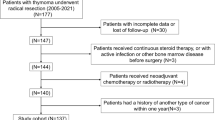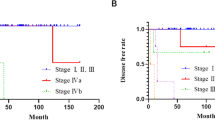Abstract
Background
Cell-cycle protein (p27, p21, and p53) expression can predict response to neoadjuvant chemotherapy and prognosis in some neoplasms. This study evaluated whether these markers could also be effective in invasive thymoma during a multimodality treatment.
Methods
Between 1989 and 2008, 33 patients with invasive thymoma underwent surgical resection after neoadjuvant chemotherapy. Expression of p27, p21, and p53 was assessed using immunohistochemistry in specimens retrieved pre and post chemotherapy. Factors influencing response to neoadjuvant chemotherapy and survival were investigated by univariate and multivariate analysis. Good response was defined as complete disappearance of tumor at imaging or necrosis >90% at pathologic studies.
Results
Twelve patients disclosed an imaging good response. Complete resection was possible in 17 patients, 9 of whom had presented imaging good response and 11 of whom had revealed pathologic good response. On univariate analysis both imaging and pathologic poor responses were significantly associated with incomplete resection (P = 0.04 and P = 0.03, respectively) and preneoadjuvant triple combination of p27 low, p21 low, and p53 high expressions (P = 0.001 and P < 0.0001, respectively), the last factor being the only one selected on logistic regression (P = 0.01 and P = 0.005, respectively). Long-term survival analysis was negatively influenced by triple combination of p27, p21, and p53 (P < 0.0001) and incomplete resection (P < 0.0001), which were also selected on Cox’s regression (P = 0.004 and P = 0.02, respectively).
Conclusions
The triple combination of p27 low, p21 low, and p53 high expressions was the most significant predictor of imaging and pathologic poor responses to neoadjuvant chemotherapy in invasive thymoma. This combination together with incomplete resection was also the most significant negative predictor of long-term survival.



Similar content being viewed by others
References
Jackson MA, Mall DL. Post-operative radiotherapy in invasive thymoma. Radiother Oncol. 1991;21:77–82.
Regnard JF, Magdeleinat P, Dromer C, Dulmet E, de Montpreville V, Levi JF, et al. Prognostic factors and long-term results after thymoma resection. A series of 307 patients. J Thorac Cardiovasc Surg. 1996;112:376–84.
Okumura M, Miyoshi S, Tacheichi Y, Yoon HE, Takeda SI, Fujii Y, et al. Results of surgical treatment of thymomas with special reference to the involved organs. J Thorac Cardiovasc Surg. 1999;117:605–13.
Wilkins KB, Sheikh E, Green R, Patel M, George S, Takano M, et al. Clinical and pathologic predictors of survival in patients with thymoma. Ann Surg. 1999;230:562–74.
Strobel P, Bauer A, Puppe B, Kraushaar T, Krein A, Toyka K, et al. Tumor recurrence and survival in patients treated for thymomas and thymic squamous cell carcinomas: a retrospective analysis. J Clin Oncol. 2004;22:1501–09.
Masaoka A, Monden Y, Nakahara K, Tanioka T. Follow-up study of thymomas with special reference to their clinical stages. Cancer. 1981;48:2485–92.
Macchiarini P, Chella A, Ducci F, Rossi B, Testi C, Bevilacqua G, et al. Neoadjuvant chemotherapy, surgery, and postoperative radiation therapy for invasive thymoma. Cancer. 1991;68:706–13.
Loehrer PJ Sr, Chen M, Kim K, Aisner SC, Einhorn LH, Livingston R, et al. Cisplatin, doxorubicin, and cyclophosphamide plus thoracic radiation therapy for limited-stage unresectable thymoma: an intergroup trial. J Clin Oncol. 1997;15:3093–9.
Shin DM, Walsh GL, Komaki R, Putnam JB, Nesbitt J, Ro JY, et al. A multidisciplinary approach to therapy for unresectable malignant thymoma. Ann Intern Med. 1998;129:100–4.
Sherr CS. Cancer cell cycles. Science. 1996;274:1672–77.
Grana X, Reddy EP. Cell cycle control in mammalian cells: role of cyclins, cyclin dependent kinases (CDKs), growth suppressor genes and cyclin-dependent kinase inhibitors. Oncogene. 1995;11:211–9.
Kirsch DG, Kastan MB. Tumor-suppressor p53: implications for tumor development and prognosis. J Clin Oncol. 1998;16:3158–68.
Esposito V, Baldi A, Tonini G, Vincenzi B, Santini M, Ambrogi V, et al. Analysis of cell-cycle regulator proteins in non-small cell lung cancer. J Clin Pathol. 2004;57:58–63.
Luna-Perez P, Arriola EL, Cuadra Y, Alvarado I, Quintero A. p53 protein overexpression and response to induction chemoradiation therapy in patients with locally advanced rectal adenocarcinoma. Ann Surg Oncol. 1998;5:203–8.
Moore HG, Shia J, Klimstra DS, Ruo L, Mazumdar M, Schwartz GK, et al. Expression of p27 in residual rectal cancer after preoperative chemoradiation predicts long-term outcome. Ann Surg Oncol. 2004;11:955–61.
Mineo TC, Ambrogi V, Mineo D, Baldi A. Long-term disease-free survival of patients with radically resected thymomas. Cancer. 2005;104:2063–71.
Chen G, Marx A, Wen-Hu C, Yong J, Puppe B, Stroebel P, Mueller-Hermelink HK. New WHO histologic classification predicts prognosis of thymic epithelial tumors. Cancer. 2002;95:420–29.
Junker K, Thomas M, Schulmann K, Klinke F, Bosse U, Müller KM. Tumor regression in non-small-cell lung cancer following neoadjuvant therapy. Histological assessment. J Cancer Res Clin Oncol. 1997;123:469–77.
Rosai J, Levine GD. Tumors of the thymus. In: Atlas of tumor pathology, 2nd series, fascicle 13. Armed Forced Institute of Pathology, Washington, DC; 1976.
Maggi G, Giaccone G, Donadio M, Ciuffreda L, Dalesio O, Leria G, et al. Thymoma: A review of 169 cases, with particular reference to results of surgical treatment. Cancer. 1986;58:765–76.
Giaccone G, Ardizzoni A, Kirkpatrick A, Clerico M, Sahmoud T, van Zandwijk N. Cisplatin and etoposide combination chemotherapy for locally advanced or metastatic thymoma: a phase 2 study of the European Organisation for Research and Treatment of Cancer, Lung Cancer Cooperative Group. J Clin Oncol. 1996;14:814–20.
Thomas CR, Wright CD, Loehrer PJ. Thymoma: state of the art. J Clin Oncol. 1999;17:2280–90.
Froudarakis ME, Tiffet O, Fournel P, Briasoulis E, Karavasilis V, Cuilleret J, et al. Invasive thymoma: a clinical study of 23 cases. Respiration. 2001;68:376–81.
Kondo K. Optimal therapy for thymoma. J Med Invest. 2008;55:17–28.
Kondo K, Monden Y. Therapy for thymic epithelial tumors: a clinical study of 1,320 patients from Japan. Ann Thorac Surg. 2003;76:878–84.
Detterbeck FC, Parsons AM. Thymic tumors. Ann Thorac Surg. 2004;77:1860–9.
Wright CD, Choi NC, Wain JC, Mathisen DJ, Lynch TJ, Fidias P. Induction chemoradiotherapy followed by resection for locally advanced Masaoka stage III and IVa thymic tumors. Ann Thorac Surg. 2008;85:385–9.
Kumar A, Regmi SK, Dutta R, Kumar R, Gupta SD, Das P, et al. Characterization of thymic masses using (18)F-FDG PET-CT. Ann Nucl Med. 2009;23:569–77.
Acknowledgment
This research was supported by the grant 60% 2005 from the Tor Vergata University and from the Italian Health Ministry according to the project “Profilo genetico associato al fenotipo metastatico e alla prognosi nei tumori polmonari”.
Author information
Authors and Affiliations
Corresponding author
Additional information
This study was carried out by Dr. Davide Mineo within the Research Fellowship Program “Tecnologie e Terapie Avanzate di Chirurgia” awarded by Tor Vergata University, Rome, Italy.
Rights and permissions
About this article
Cite this article
Mineo, T.C., Mineo, D., Onorati, I. et al. New Predictors of Response to Neoadjuvant Chemotherapy and Survival for Invasive Thymoma: a Retrospective Analysis. Ann Surg Oncol 17, 3022–3029 (2010). https://doi.org/10.1245/s10434-010-1134-9
Received:
Published:
Issue Date:
DOI: https://doi.org/10.1245/s10434-010-1134-9




